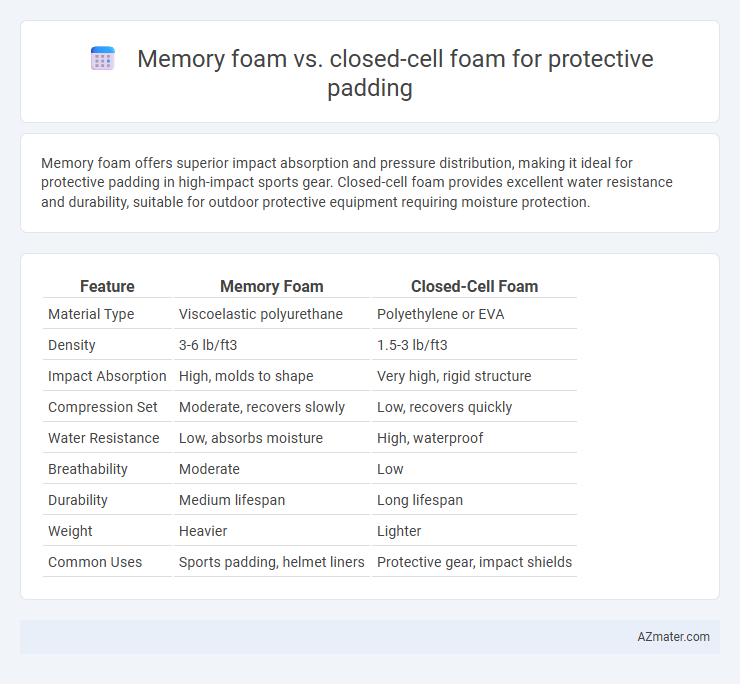Memory foam offers superior impact absorption and pressure distribution, making it ideal for protective padding in high-impact sports gear. Closed-cell foam provides excellent water resistance and durability, suitable for outdoor protective equipment requiring moisture protection.
Table of Comparison
| Feature | Memory Foam | Closed-Cell Foam |
|---|---|---|
| Material Type | Viscoelastic polyurethane | Polyethylene or EVA |
| Density | 3-6 lb/ft3 | 1.5-3 lb/ft3 |
| Impact Absorption | High, molds to shape | Very high, rigid structure |
| Compression Set | Moderate, recovers slowly | Low, recovers quickly |
| Water Resistance | Low, absorbs moisture | High, waterproof |
| Breathability | Moderate | Low |
| Durability | Medium lifespan | Long lifespan |
| Weight | Heavier | Lighter |
| Common Uses | Sports padding, helmet liners | Protective gear, impact shields |
Introduction to Protective Padding Materials
Memory foam offers superior impact absorption and conforms closely to body contours, making it ideal for protective padding that requires cushioning and pressure distribution. Closed-cell foam provides excellent rigidity and water resistance, enhancing durability and protection in harsher environments. Selecting between memory foam and closed-cell foam depends on the balance between comfort and structural support needed in protective applications.
What is Memory Foam?
Memory foam is a viscoelastic material known for its ability to conform to the shape of the body, providing superior cushioning and pressure distribution in protective padding. Unlike closed-cell foam, which consists of dense, airtight cells that resist impact by compression, memory foam slowly deforms under pressure and gradually returns to its original shape, enhancing comfort and shock absorption. This unique property makes memory foam ideal for applications requiring adaptive support and prolonged protection.
What is Closed-cell Foam?
Closed-cell foam is a dense, durable material characterized by its tightly packed, sealed cells that prevent water absorption and provide excellent impact resistance, making it ideal for protective padding. Unlike memory foam, closed-cell foam offers superior rigidity and moisture resistance, enhancing durability in environments exposed to moisture or high pressure. Its lightweight nature combined with high compressive strength ensures effective cushioning and protection in sports gear, safety equipment, and industrial applications.
Key Differences Between Memory Foam and Closed-cell Foam
Memory foam offers superior contouring and pressure distribution due to its viscoelastic properties, making it ideal for impact absorption in protective padding. Closed-cell foam features a rigid, dense structure with high water resistance and excellent durability, providing firm protection and structural support. The key differences lie in memory foam's cushioning comfort versus closed-cell foam's toughness and moisture resistance, influencing their specific applications in protective gear.
Impact Absorption Capabilities
Memory foam exhibits superior impact absorption capabilities due to its open-cell structure that compresses slowly, dissipating energy effectively and reducing pressure point forces. Closed-cell foam provides excellent resistance to majority of impacts by quickly distributing force across its dense, rigid structure, making it ideal for high-impact scenarios where rapid force dispersion is needed. Compared to memory foam, closed-cell foam offers less conformability but higher durability and moisture resistance, enhancing its long-term protective performance in rugged environments.
Comfort and Fit Considerations
Memory foam contours precisely to body shapes, offering superior comfort and personalized fit by evenly distributing pressure and reducing impact points. Closed-cell foam provides firm support and excellent shock absorption with a denser structure that resists water and moisture, maintaining shape under consistent stress. For protective padding, memory foam excels in comfort and adaptability, while closed-cell foam ensures durability and stable cushioning in high-impact environments.
Durability and Lifespan
Memory foam offers excellent impact absorption but tends to degrade faster over time due to its open-cell structure, which allows for moisture retention and compression set. Closed-cell foam provides superior durability and a longer lifespan as its dense, water-resistant composition resists deformation, wear, and environmental damage. For protective padding applications requiring extended use, closed-cell foam is often preferred because it maintains structural integrity and shock absorption capabilities longer than memory foam.
Moisture Resistance and Maintenance
Closed-cell foam offers superior moisture resistance due to its dense, non-porous structure that prevents water absorption and inhibits mold growth, making it ideal for protective padding in wet environments. Memory foam, while providing excellent cushioning and pressure relief, tends to retain moisture and requires regular maintenance such as air drying and cleaning to prevent mildew and odor buildup. For long-term durability and low-maintenance care, closed-cell foam outperforms memory foam in moisture resistance and overall upkeep.
Typical Applications in Protective Gear
Memory foam excels in applications requiring high impact absorption and pressure distribution, such as in helmets, knee pads, and sports gloves, due to its viscoelastic properties that conform to body contours. Closed-cell foam is widely used in protective gear like life jackets, elbow pads, and shin guards because of its excellent water resistance, durability, and lightweight cushioning. Its closed-cell structure prevents moisture absorption, making it ideal for wet environments and prolonged use in protective padding.
Choosing the Right Foam for Your Needs
Memory foam offers superior impact absorption and comfort, making it ideal for protective padding where cushioning and pressure distribution are essential. Closed-cell foam provides high durability, water resistance, and excellent shock absorption, suitable for outdoor and heavy-duty protection. Selecting the right foam depends on prioritizing comfort and flexibility with memory foam or durability and moisture resistance with closed-cell foam.

Infographic: Memory foam vs Closed-cell foam for Protective padding
 azmater.com
azmater.com